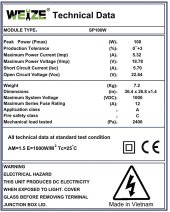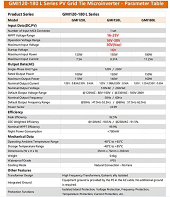KnightLune
New Member
- Joined
- Jun 2, 2022
- Messages
- 6
So, as some background, I am COMPLETELY new to solar in general. So go easy with me. My only real best method of learning is diving right into things myself. I've been trying to keep up with reading and other methods of educating myself, including videos and whatnot, for the past six or seven months. To say I am a little green is an understatement. I am also poor as heck, so dropping money on anything "good" is a bit out of the question for me, though I'd eventually like to upgrade to better equipment. I've been looking for cheap as heck hardware on sale, mostly imported from China, and... yeah, I'm aware this sounds like a train wreck already.
That said, a couple of weeks ago, I decided to bite the bullet and buy a cheap ($40-ish, at the time) 100 watt panel that was on sale on Amazon. Specifically, a WEIZE 100 watt panel as detailed in the attached sticker image. With it, I got a 140 watt Y&H grid-tie micro inverter at another ~$40. Also displayed in the Attachments.


I hooked up the two properly, and ran it directly to the wall to see that under peak hours I was getting roughly ~85 watts from it. This was acceptable for me, and I figured the performance was suffering slightly due to potential angle mismatch, plus the efficiency of the gear in question. Whether this is the case or not is up for debate. If it's hardware-related, please do let me know!
Cool. So, it worked. I was pretty excited since it was my first ever foray into doing something like this, period, and as simple as it may seem for some, was pretty difficult for me, but it worked. Woo!
At this point I decided to snag a deal on a new 190 watt panel from HQST, since I heard good things about their stuff. ~$200 worth of hardware to get this panel and the inverter, plus the cables and everything else that was required. The inverter is from the same brand, but the 180 watt version. Also attached is the info for the devices in question.
Second Panel Info:
These two panels are hooked up to an industrial power distribution unit I had laying around from a previous job. The main output from that is connected directly to a plug which is on a separate breaker box with a single 100 amp breaker.
Unfortunately, with these two panels? 170 watt maximum at peak hours on a bright, sunny day. I understand that the inverter is rated for a max of 180 watts, with a max output of 150 watts, but unless I should have failed third grade math, that means that I should, in theory, see 250 watt output with both inverters and these panels. However, most of the time, with both panels connected, I'm lucky if I see 170 watts maximum. So I'm missing out on 80 watts?
Can someone provide some insight here? If I'm missing some details that are required to receive assistance, please let me know. If I'd be better off with another micro-inverter for the second panel, recommendations are welcome. I do have free returns on the inverters for the next twenty or so days, and if I just fudged and bought the wrong stuff... well, my bad. Though at least I learned my mistake.
Looking forward to hearing your responses, but please do go easy on me.
That said, a couple of weeks ago, I decided to bite the bullet and buy a cheap ($40-ish, at the time) 100 watt panel that was on sale on Amazon. Specifically, a WEIZE 100 watt panel as detailed in the attached sticker image. With it, I got a 140 watt Y&H grid-tie micro inverter at another ~$40. Also displayed in the Attachments.


I hooked up the two properly, and ran it directly to the wall to see that under peak hours I was getting roughly ~85 watts from it. This was acceptable for me, and I figured the performance was suffering slightly due to potential angle mismatch, plus the efficiency of the gear in question. Whether this is the case or not is up for debate. If it's hardware-related, please do let me know!
Cool. So, it worked. I was pretty excited since it was my first ever foray into doing something like this, period, and as simple as it may seem for some, was pretty difficult for me, but it worked. Woo!
At this point I decided to snag a deal on a new 190 watt panel from HQST, since I heard good things about their stuff. ~$200 worth of hardware to get this panel and the inverter, plus the cables and everything else that was required. The inverter is from the same brand, but the 180 watt version. Also attached is the info for the devices in question.
Second Panel Info:
- Maximum Power: 190 W
- Open-Circuit Voltage (Voc): 24.3 V
- Short-Circuit Current (Isc): 10.15 A
- Optimum Operating Voltage (Vmp): 20.3 V
- Optimum Operating Current (Imp): 9.36 A
- Operating Temperature: -40°F to 194°F
- Maximum System Voltage: 600 V DC UL
- Maximum Series Fuse Rating: 15A
These two panels are hooked up to an industrial power distribution unit I had laying around from a previous job. The main output from that is connected directly to a plug which is on a separate breaker box with a single 100 amp breaker.
Unfortunately, with these two panels? 170 watt maximum at peak hours on a bright, sunny day. I understand that the inverter is rated for a max of 180 watts, with a max output of 150 watts, but unless I should have failed third grade math, that means that I should, in theory, see 250 watt output with both inverters and these panels. However, most of the time, with both panels connected, I'm lucky if I see 170 watts maximum. So I'm missing out on 80 watts?
Can someone provide some insight here? If I'm missing some details that are required to receive assistance, please let me know. If I'd be better off with another micro-inverter for the second panel, recommendations are welcome. I do have free returns on the inverters for the next twenty or so days, and if I just fudged and bought the wrong stuff... well, my bad. Though at least I learned my mistake.
Looking forward to hearing your responses, but please do go easy on me.
Last edited:



